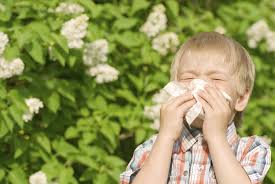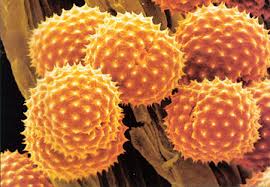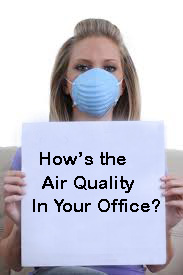Indoor Air Quality (IAQ)

People in the United States spend up to 90% of their time inside home, offices and buildings. It is believed that the adverse effect of indoor pollutants can significantly affect people’s health and so Indoor Air Quality (IAQ) has become a major concern in recent years.
EFFECTS OF POOR IAQ

Poor indoor air quality (IAQ) has been tied to symptoms like headaches, fatigue, trouble concentrating, and irritation of the eyes, nose, throat and lungs. Also, some specific diseases have been linked to specific air contaminants or indoor environments, like asthma with damp indoor environments. In addition, some exposures, such as asbestos and radon, do not cause immediate symptoms but can lead to cancer after many years. In other words the quality of indoor air inside homes is important not only for people’s comfort but also for their health.
Click Here to Request a Call Back or To Make An Appointment
MANY FACTORS AFFECT IAQ

These factors include poor ventilation (lack of outside air), problems controlling temperature, high or low humidity, recent remodeling, and other activities in or near a building that can affect the fresh air coming into the building. Sometimes, specific contaminants like dust from construction or renovation, mold, cleaning supplies, pesticides, or other airborne chemicals (including small amounts of chemicals released as a gas over time) may cause poor IAQ.
HOW TO IMPROVE YOUR OFFICE IAQ?

The first step towards taking action to improve your IAQ is to know your home.
At the forefront, the simplest solutions involve a discriminatory approach to choosing your furniture and other accessories with the least toxicity, selecting low-pollutant emitting carpet, monitor CO levels, etc.
Ultimately proper ventilation in a home/building can prevent and fix IAQ problems.
So another simple approach is to ventilate your home/office except if the outside air is particularly polluted.
HOW TO IMPROVE YOUR HOME IAQ?

If the air around your home is very polluted or you or your family suffer respiratory difficulties, then usage of SPECIAL air filtration system can reduce the amount of allergens and pathogens circulating in the home.
Our team of experts at Fix My AC Inc. will help determine what solution is the best fit for your situation.
Ultimately proper ventilation in a home/building can prevent and fix IAQ problems.
So another simple approach is to ventilate your home/office except if the outside air is particularly polluted.
HERE ARE SOME COMMON MYTHS ABOUT IAQ
MYTH 1: Indoor Air is better than Outdoor air: EPA indicated that Indoor Air may be up to 5 times as polluted as outdoor air. The trend is worsening as houses are built tighter thereby reducing air exchange between outside and inside air and avoiding heat loss in the winter and heat gain in the summer, altogether increasing energy efficiency but also concentrating indoor air pollutants.
MYTH 2: Indoor Air Pollutant: There are many types of Indoor Air Pollutants including Volatile Organic Compounds produced by building materials, furniture, paint, carpet, pesticides and cleaning materials, Molds and other Biological Contaminants like dust mites, bacteria and viruses, Noxious Gases like carbon monoxide, Toxic Components like asbestos, lead and radon and Allergenic Particles like dander and pollens.
MYTH 3: Noxious gases are visible or have a recognizable odor. Unfortunately many noxious gases are neither visible nor odorant so that we need to use special monitoring devices to let us know of their presence. Carbon Monoxide for example is a colorless, odorless and tasteless gas which is slightly lighter than air but highly toxic. OSHA (Occupational Safety and Health Administration) limits long-term workplace exposure levels above 50 ppm. Similarly due to the health risks associated with carbon dioxide exposure, OSHA says that average exposure for healthy adults during an eight-hour work day should not exceed 5,000 ppm (0.5%).
MYTH 4: Regular air filter in the furnace aims at improving IAQ. In fact, the air filter in your Heating and Air conditioning systems are meant to protect the HVAC system the same way that your car air filter is meant to protect your car engine and not the cabin air quality. However, as a side effect, some air filters of higher quality will improve the IAQ provided they are properly sized, correctly put in place and frequently replaced. The ability to filter particles by air filters is measured in MERV. The higher the MERV number, the higher filtration capacity. Basic mesh filters – blue or green – (MERV below 4) trap particles 10microns or larger Therefore they let many of the air contaminants go through and do not qualify as improving IAQ. Pleated air filters with MERV between 5 to 8 are better for your HVAC system and can trap between 30 to 80% of particles as small as 3 microns, thereby reducing the amount of large pollutants of indoor air.
MYTH 5: Air duct cleaning for home should be performed regularly: The EPA (Environmental Protection Agency) declares that duct cleaning has never been shown to actually prevent health problems. The agency recommends doing ducts cleaning only when - and if - needed and even mentions replacing the ducts rather then cleaning them in some cases. The fact is that Air Ducts in most homes are made of flexible ducts which are circular pipes, made of fragile material, loosely connected to one another and holding together thanks to some duct tape. As these ducts age, they become sensitive to both shaking (glue dries out and ducts open up in your attic) and poking (outside lining becomes brittle and breaks easily so air flows to your attic). So Air Duct cleaning for home may not improve the IAQ while potentially causing significant damages and air leaks to the inhabited space.
MYTH 6: Room Air Cleaners significantly improve IAQ of your home. Most room cleaners are unable to circulate enough air in a given time frame to catch all the contaminants of a single room, let alone of a complete house. Moreover many of them charge the particles which make them stick to walls, furniture and carpets (making your home looking dirty) and never go through the filtration systems (meaning the air pollutants go back into the air when you touch the surfaces of your home).
